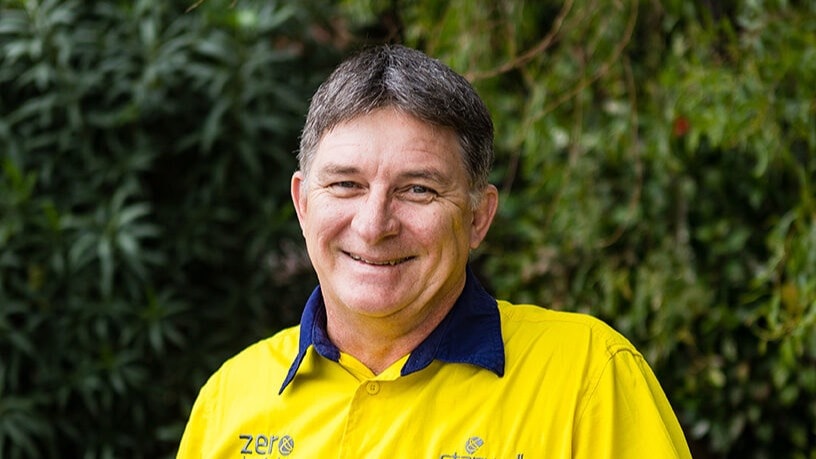The road to renewables: How Stanwell is creating pathways to a bright future
The road to renewables: How Stanwell is creating pathways to a bright future

Peter Woodall has always had a knack for being able to see the big picture. Now, as Stanwell’s Future Pathways Manager, he’s helping to ensure our people and our communities benefit from Queensland’s clean energy future.
“I’ve been at Stanwell for more than two decades,” Peter says, “and one of the things I’ve found very rewarding in that time is watching people develop – whether it’s an apprentice learning their trade, or seeing someone grow into a leadership position. As the industry transitions to renewables, I want to help our people continue to develop the skills they’ll need to succeed.”
As Stanwell’s Future Pathways Manager, Peter’s role is to identify the skills Stanwell has in our current workforce and the skills that will be required as we increase our renewable energy production; and to develop career pathways and opportunities for our people in Queensland’s renewable future.
“It’s about knowing where we want to be in 5 or 10 years,” he says, “and identifying what we need to do now to get there.”
According to Plan
The Queensland Energy and Jobs Plan (QEJP) has set a target of 80 per cent renewable energy for the state by 2035, and with the state’s largest pipeline of renewable generation and storage in development, Stanwell is set to play a key role in this transition.
By 2035, our renewable energy assets will power up to 40 per cent of Queensland’s current energy demand with clean energy. Stanwell’s existing power stations are expected to have been converted into clean energy hubs by that time, creating ongoing job opportunities.
As a government-owned corporation (GOC), Stanwell was involved in the development of the QEJP. Peter’s role in this process was to help develop the Queensland Energy Workers’ Charter and the Job Security Guarantee, which provides affected energy GOC workers with assurances that they’ll have a job within the government-owned energy sector as it transforms.
“My favourite thing about this role is helping to give people some options, choice and clarity about their future, and the Job Security Guarantee helps to provide that clarity,” Peter says. Stanwell CEO Michael O’Rourke sits on the newly established interim Energy Industry Council, which will provide advice to the Queensland Government on new opportunities and pathways for these workers and their communities.
“Priorities for the Energy Industry Council include identifying the critical skills that will be needed to continue operating our existing power stations, so that they can continue to provide safe, reliable and affordable electricity for as long as they’re needed,” Peter says, “and identifying who our affected workers will be during the energy transformation. Part of this will include developing individual transition plans for our affected workers.”
Peter serves on an Energy Industry Council sub-committee that will identify workable solutions and provide recommendations to the Council.
“Part of my role is working with government departments and education providers to identify what the roles of the future will be, and which roles they align with at our existing power stations, so we can determine which skills can be transferred and which skills will need to be developed,” he says.“Currently I’m providing industry input on the Future Energy Workforce Roadmap, which will identify opportunities to build and develop energy workforce capacity and capability.
“Last year, I worked with the Department of Employment, Small Business and Training on the Hydrogen Industry Workforce Development Roadmap, which was aimed at building a pipeline of skilled, hydrogen-ready workers. The Future Energy Workforce Roadmap will fulfil a similar role for the wider industry.”
Lighting the spark
Internally, Peter says a priority of his as Stanwell’s Future Pathways Manager is to develop a skills matrix for our own renewable generation and storage projects.
“The skills matrix will detail what we need, what we already have in-house, and what we need to develop, so we can start giving our people more specific and tangible information about the jobs of the future,” he says.
“When you look at the pipeline of renewables, it seems there are going to be more vacant jobs than there are currently skilled workers to fill them. So it’s not just about upskilling our people; it’s also about broadening our talent pool, so we have the workforce to do all of these future jobs.
“That’s why we’re working with education providers to develop STEM programs that will get young people interested in renewables, and why we recently sponsored two teams from Gladstone to build hydrogen-powered cars and enter the Hydrogen Grand Prix. That’s our future workforce, whether they end up working for Stanwell or elsewhere in the industry.”
Ultimately, Peter says the future is bright for our industry – and for our communities.
“I grew up in the South Burnett,” Peter says, “and I remember the joy when the Tarong Power Station and the Meandu Mine were announced. I remember my mum throwing her arms up in the air in triumph and saying, ‘There’s a future for my kids’. That’s what I get to be part of now as we look ahead to the energy transformation.
“Stanwell’s renewable energy pipeline should give people that same sense of excitement and opportunity that regional Queensland felt back when the last major power stations were built. It means there’s a bright future for our kids, our grandkids and our communities – that’s the bigger picture.”
Subscribe to our newsletter
STANWELL SPARK
Stay up to date with quarterly news from Stanwell, delivered straight to your inbox. Learn more about our projects, partnerships and how we're delivering affordable, reliable and secure electricity for Queensland.